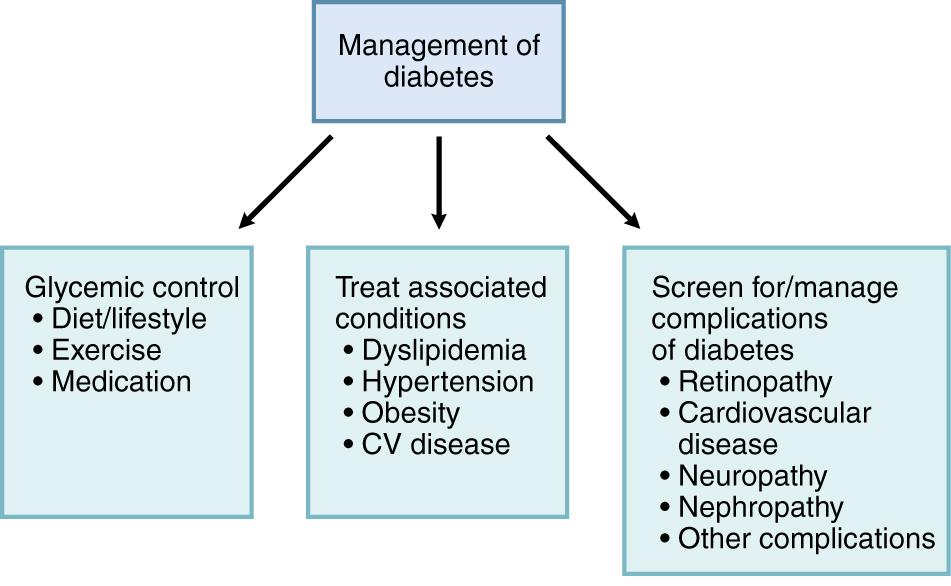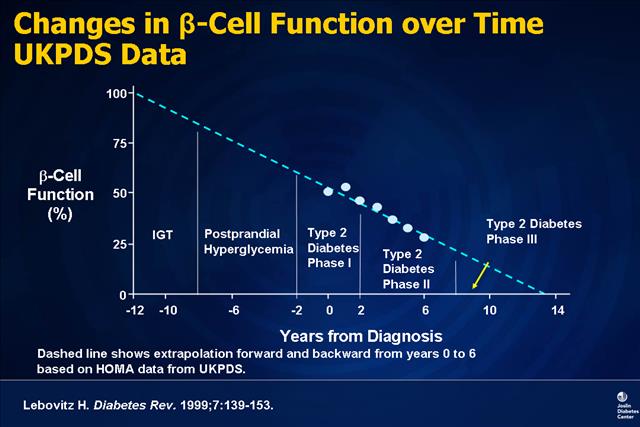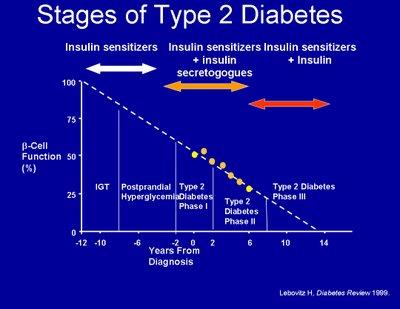
Diabetes: a therapeutic framework
DIABETES MELLITUS
Understanding Type 1 and Type 2
Diabetes and Disease Progression
Buge Apampa PhD MRPharmS
Some Questions to start off!
1. How many people are expected to have diabetes
in the UK by 2025? [5m]
2. What is the estimated hourly cost of diabetes to
3. How many diabetic patients are dying avoidably
each year? [24,000]
4. How many parameters must be checked annually
in diabetic patients? [9]
5. What % of patients treated with insulin for < 2y
reported a hypoglycaemic episode? [51%]
Objectives
•Burden of Diabetes Mellitus •Refresher of Type 1 & Type 2 DM
•Evidence base for management •Optimising your professional role
Burden of Diabetes Mellitus
Commonest
amputations
Single largest cause
Depression
of blindness
Kidney Disease
Diabetes
Stroke – 2-4 x
Heart attack: 2-4 x death
increased risk
• 10% of NHS budget
• 2002- NHS spend of £1.3 billion
• 2011- NHS spend on diabetes nearly £10
• Net ingredient cost of £760.3m (9% of all
total cost of Rxs)
NICE 2008 Targets
Average 6.5% 48 mmol/mol
Total Cholesterol
Nine Diabetes Checks
1. Blood pressure
2. Weight and waist circumference
4. HbA1C 5. Urinary albumin
6. Serum creatinine
7. Foot & leg check
8. Smoking status
9. Eyes- retinal screening
National Diabetes Audit
• Reviewed records of 1.7m diabetics in England &
Wales for 9 recommended checks
• 50% of Type 2 DM received the checks
• 33% of Type 1 DM received the checks
• Completion influenced by ethnicity & age
• Younger people less likely to receive checks
Preventing additional deaths in people
with Diabetes
(Diabetes health Intelligence YHPHO)
• England 2011, diabetics
had 39.9% greater risk of dying compared to general population
• Over 20,000 additional
deaths among diabetics
• If all PCTs with highest
additional risk of diabetics dying reduced the risk to the England ave 2150 fewer deaths in 2011


Preventing Disease Progression: Is there a Role for Pharmacists?
Some Facts about Diabetes
• About 3 million people with diabetes in UK • Represents 72% of estimated prevalence • 12 times more type 2 than type 1 • Prevalence increasing- ageing population and obesity • 8% Type 1 diabetes - can occur at any age after 18m
but has peak incidence in children aged10-15y
• 92% Type 2 diabetes • 850,000 thought to be undiagnosed • 40% increased prevalence among people in deprived
• Prevalence of diabetes nearly 4 times higher than
prevalence of all cancers combined
Possible signs/symptoms of diabetes
• Increased thirst • Polyuria • Recurrent infection • Diabetic complication • Weight loss • Extreme tiredness or lethargy • Slow wound healing • Itchy skin rash • Blurred vision • Tingling pain & numbness in feet, legs or hands
WHO diagnostic thresholds for venous plasma
glucose (mmol/l)
Diabetes ≥ 7.0
≥11.1 ≥11.1
mellitus
Impaired N/A
< 11.1 ≥7.8
<11.1
Impaired 6.1-<7.0
affected
48 mmol/mol by food
Type 1 vs. Type 2 diabetes
Lambert P, et al. Medicine 2006; 34(2): 47-51
Nolan JJ. Medicine 2006; 34(2): 52-56
Features of type 1 diabetes
Features of type 2 diabetes
• Usually presents in over-30s (but
also seen increasingly in younger
childhood/adolescence
• Lean body habitus
• Associated with overweight/obesity
• Acute onset of osmotic
• Onset is gradual and diagnosis
often missed (up to 50% of cases)
• Ketosis-prone
• Not associated with ketoacidosis,
though ketosis can occur
• High levels of islet
• Immune markers in only 10% • Family history is often positive with
• High prevalence of genetic
almost 100% concordance in
1. Gestational diabetes: Diabetes first
diagnosed in pregnancy irrespective of cause
2. Latent autoimmune diabetes of adults (slowly
progressing type 1?)
3. Type 2 diabetes presenting with diabetic
ketoacidosis (common in UK black population; acute partial temporary β-cell failure; complete remission)
4. Type 2 diabetes presenting in children and
Complications of Diabetes
Disease Progression
• In the late 80s, 44% o f patients in the West with
type 2 DM, died within 10 years of diagnosis mostly due to macrovascular disease
• Incidence & mortality from CVD 2-3 x greater
than the general population
• Complications present in up to 50% at
• Other risk factors for CVD (hypertension,
hyperlipidaemia) present
• Long term damage of eyes, kidney, nerves,
heart and blood vessels
UKPDS: Progressive Deterioration in
Glycemic Control Over Time
Macrovascular Complications
• More common in Type 2
• Myocardial infarction
• Ischaemic heart disease
• Cerebrovascular disease
• Peripheral vascular disease
Microvascular Complications
• More common in Type 1
• Retinopathy present in all patients after 20
years. Can lead to blindness
• Nephropathy accounts for 1 in 4 kidney
• 40% Type 1 and 20% Type 2 develop end
stage renal disease
• Neuropathy (nerve pain, amputation, ED)

Type 1 Diabetes - A Refresher
Type 1 Diabetes
• Autoimmune destruction of pancreatic β cells
(viral or autoimmune)
• Immediate and permanent requirement for
• Insulin requirement may be minimal during
‘honeymoon' period (6-18 months after diagnosis)
• Fatal if not treated
Clinical presentation
• Rapid/abrupt onset of acute osmotic symptoms • Ketonuria and / or metabolic acidosis at presentation
• Unintentional weight loss which may or may not be
accompanied by ketoacidosis
• Vascular complications not evident at presentation
Pharmacotherapy-Type 1 DM
• Insulin: all Type 1 DM will require insulin • Subcutaneous route is preferred however
intravenous route is used (soluble insulin) in emergencies
• 3 main types of insulin available: • Short acting - soluble insulin, lispro and aspart,
• Intermediate - isophane zinc and insulin zinc susp. • Slower onset and longer acting - crystalline insulin
zinc susp, detemir, glargine
Goals of Insulin Treatment
• To mimic both types of insulin secretion • Require basal insulin and meal-related insulin
• General requirements: 1unit/kg/24h in type 1 • Insulin analogues e.g. Humalog, NovoRapid →
better mimic physiological profile of insulin, improved control
• More convenient for patients, can be used
15mins before to immediately after a meal
• Reduced frequency of "hypos" due to shorter
Approximate pharmacokinetic profiles of
human insulin and insulin analogues
Hirsch IB. N Engl J Med 2005; 352: 174-83
N.B. Duration of action will vary widely between and within people
NPH = neutal protamine hagedorn/isophane insulin
Insulin choices in adults:
• Meal time insulin
– soluble – rapid acting analogues where "hypos" a
• Basal Insulin
– Isophane (NPH) at bedtime or bd – Long acting analogues (glargine) where
night time "hypos" or morning "hypers" a problem with NPH or rapid acting meal time analogues used
NICE Insulin Regimens
• Multiple insulin injections: for adults who prefer
them as part of an integrated package of education, food, skills training and self-monitoring
• Twice-daily insulin regimens:
1. for those who find adherence difficult
2. adults with learning difficulties who may require
3. where no of injections is a quality of life issue 4. Biphasic insulin preparations are often the
preparation of choice
5. Biphasic rapid-acting insulin analogue premixes may
give an advantage to those prone to hypoglycaemia at
Supporting Evidence Base: DCCT 1993
• Intensive treatment vs conventional
• 1,441 patients with Type 1 diabetes, mean age 27
• Active group- insulin 3-4 times a day with >4 blood
tests a day supported by monthly clinics
• Control group received twice daily insulin and
standard monitoring
• 60% reduction in microvascular complications
• 44% reduction in macrovascular complications
• Conclusion: Tight control with intensive insulin therapy
reduces development & progression of microvascular outcomes
Factors affecting insulin requirements
Increased insulin
Decreased insulin requirements
• Renal failure
• Adrenal insufficiency
• Increased exercise
• Inactivity • Hyperthyroidism • Cushing disease
Type 2 Diabetes - A Refresher
Type 2 Diabetes
• Relative insulin deficiency due to disorders of insulin action
(insulin resistance) or secretion
• Progressive disease; β cell dysfunction to IGT to T2DM • β cell dysfunction starts before blood glucose rises and
worsens after diabetes develops
• Failure of β cell to adequately compensate for insulin
• Strong genetic basis for β cell failure (Asians, Middle Eastern,
African-Caribbeans & Africans)
• Linked to hypertension and obesity (most common cause of
insulin resistance)
Risk factors for Type 2 diabetes
• Obesity, BMI > 30; 47% of Type 2 DM in England (NAO)
• Age (> 40 if white; > 25 if black, asian)
• Waist measurement > women 31.5in; 35in Asian men;
37in white or black men
• Sedentary lifestyle – 30-40% increased risk
• Ethnicity: African-Caribbean, South Asian, Middle
• Family history – 1st degree relative
Other Risk Factors for Type 2 diabetes
• Social deprivation- diabetes-related mortality
higher in lower SEGs
• Large birth weight baby > 4.5kg
• Previous gestational diabetes • Hypertension or dyslipidaemia (metabolic
• Impaired fasting glycaemia and impaired
glucose tolerance
Clinical Presentation
• Onset of osmotic symptoms over a variable period • Positive family history- 1st degree relatives
• Variable weight loss
• Glucose excellent medium for microbial growth -
presenting symptoms may include recurrent vaginal, respiratory infections
• Hypergylcaemia – 7-10 years pre-diagnosis
• 20% have microvascular or macrovascular complications
Selected evidence base for Type 2
• Finnish, DPP, Da Qing: Intensive lifestyle
intervention studies
• UKPDS: Blood glucose and BP in patients with
• ACCORD & ADVANCE: Impact of intensive
glucose lowering in patients with high cardiovascular risk
• VADT: Impact of intensive glucose lowering in
patients with low cardiovascular risk
• HOPE: (Ramipril) • HPS (Simvastatin)
1. Lifestyle intervention
• Intensive lifestyle interventions prevent or
delay risk of progression to diabetes
• 42% reduction in Da Qing Study (China, 1997)
• 58% reduction in Finnish Diabetes Prevention
• 58% reduction Diabetes Prevention Program
2. UKPDS, 1998
• 20 year multi-centre RCT involving 5102 patients with
type 2 diabetes aged 25-65 years
• Randomised to intensive treatment or diet only therapy
• Research question:
1. Would intensive glycaemic control &/or tight BP control
reduce the risk of complications?
2. Does any specific treatment for blood sugar or blood
pressure control confer particular benefit?
2.1 UKPDS findings: Blood
• SU/Insulin vs conventional treatment lasted
• Lowering blood glucose reduced risk of;
– Eye disease by 25% – Kidney disease by 25%
• Every 1% reduction in HbA1c reduced;
– Retinopathy, neuropathy & nephropathy by
2.2 UKPDS findings: Metformin
• Median follow up was 10.7 years • Metformin compared with conventional treatment
(diet) reduced the risk of:
• Any diabetes-related endpoint by 32%
• Diabetes –related death by 42%
• All cause death by 36%
• Myocardial infarction by 39%
• Conclusion: MTF decreases the risk of death and
of having an MI, but not the risk of microvascular
complications
• ACCORD study: Intensive therapy (A1c < 6%) led to
increased mortality
• No effect on primary endpoint (MI, stroke or CV death)
• ADVANCE study: Intensive therapy (A1c < 6.5%) had no
significant effect on macrovascular events or all-cause mortality, but it did reduce nephropathy
• VADT study, 2009:Tight control of glucose did not reduce
the risk of major CV events, microvascular complications or death
• Patients in the intensive treatment arm were more likely to
experience hypoglycaemic episodes
5. UKPDS: Blood Pressure
• UKPDS: Tight BP control decreased the risk of diabetes
related death, stroke and microvascular disease
• Lowering blood pressure reduced
– Any diabetes related end point by 24% – Diabetes-related deaths by 32% – Strokes by 44% – Diabetes-related microvascular end points by 37%
• HOPE study: Ramipril significantly reduced the risk of MI,
stroke or CV death cf placebo
– MI 33% – Stroke 33% – CV death 37%
• HPS: In high-risk patients with a wide range of
baseline cholesterol values
• Simvastatin 40mg reduced:
• All-cause mortality • Coronary deaths • Major vascular events
7. Diastolic BP and Aspirin
• HOT trial: In patients with diabetes • Lowering DBP to 80mmHg
– Reduced risk of major CV events by 51%
• Aspirin 75mg
– Reduced major cardiovascular events by
– Reduced MI by 36% (P=0.002) – no effect on stroke incidence
Pharmacotherapy of Type 2
Goals of management www.npci.org.uk
• Manage symptoms • Prevent acute and late complications • Improve quality of life • Avoid premature diabetes-associated death • An individualised approach
(e.g. diet & exercise)
Microalbuminuria
Key Actions to Prevent
progression of Type 2 diabetes
1. Intensive lifestyle intervention
3. Statin therapy
4. Metformin and aspirin
5. Blood glucose control
3 Add statin
4 Add metformin
2 Control BP
(and aspirin if
5 consider
tight glucose
control
1 Lifestyle
(exercise, diet,
stop smoking)
Let's give our diabetic
patients a hand!

Lifestyle modification
• Weight reduction (5-10%) if
• Low GI CHO - pasta, basmati,
oats, beans, peas, lentils, seeds
• Replace saturated fats with
mono-unsaturated fats
• Fruits & vegetables- 5 portions
• Regular intake of fish • Less than 6g salt/day • Portion control • Control alcohol intake: 3u/2u

Lifestyle modification:
Activities of daily living
• Moderate intensity
exercise 150 min / 5 days
• More walking, cycling,
swimming, gardening
• Reduce sedentary
• Stop Smoking
2. BP: Choice of antihypertensive
NICE Diabetes Clinical Guideline 66;May 2008. NICE Full Diabetes
• BP target: <140/80 or <130/80 if complications • First-line BP lowering therapy should be a once-daily,
generic ACE inhibitor
• Exceptions to this are:
– People of African / African-Caribbean descent – Who should receive an ACE inhibitor plus either a
diuretic or a calcium-channel blocker (CCB)
• Women for whom there is a possibility of becoming
pregnant, who should receive a CCB
• Intolerance in the form of troublesome cough, substitute
an angiotensin-II receptor antagonist for the ACE inhibitor
Most patients will be on ACEI, diuretic and one other BP drug
3. Management of blood lipids
NICE Diabetes Clinical Guideline 66;May 2008. NICE Full Diabetes
• Overwhelming evidence that statins prevent CV events • Generic simvastatin (to 40mg) or a statin of similar efficacy and cost
should be initiated in people:
Aged under 40 years with poor CV risk factor profile
Aged 40+ years with low CV risk for someone with type 2 diabetes but CV risk assessed as > 20% over 10 years using UKPDS risk engine
Aged 40+ years and normal to high CV risk for someone with type 2 diabetes
Increase dose to simvastatin 80mg daily unless total cholesterol <4.0mmol/L or LDL-cholesterol <2.0mmol/L
Management of blood lipids
NICE Diabetes Clinical Guideline 66;May 2008. NICE Full Diabetes
• Intensify therapy with a more effective statin or
ezetimibe if existing or newly diagnosed CV disease or increased albumin excretion rate
• To achieve a total cholesterol level below 4.0mmol/L
or LDL-cholesterol level below 2.0mmol/L
• If TG levels remain above 4.5 mmol/L despite attention
to other causes, prescribe a fibrate
• Fibrate may be added to statin therapy if TG levels
remain in the range 2.3–4.5 mmol/L despite statins
3. Statin Therapy
• Not in patients considered at low CV risk
• Not overweight • No microalbuminuria • No history of CVD • No family history of CVD • Normotensive (BP<140/80) • No high-risk lipid profile • At high risk unless all above apply
4. Antithrombotic Therapy
NICE Diabetes Clinical Guideline 66;May 2008. NICE Full Diabetes
• Aspirin 75mg or if intolerance, clopidogrel should be
initiated in people:
1. Aged 50+ years with BP < 145/90 mmHg
2. Aged < 50 years with significant CV risk factors such
features of metabolic syndrome, strong early family history of CV disease, receiving treatment for hypertension, smokers
Antithrombotic Therapy
• Aspirin is not licensed for the primary prevention
of vascular events
• If used in primary prevention, the balance of
benefits and risks should be considered for each individual
• Presence of risk factors for vascular disease
(including conditions such as diabetes) and the risk of gastrointestinal bleeding
5. Pharmacotherapy:
Blood Glucose
• OHAs may be classed according to their mode of
1. Improve sensitivity to insulin: Biguanides & glitazones
2. Insulin secretagogues: Sulphonylureas & meglitinides
3. Reduce glucose absorption: Acarbose
4. Incretins: GLP-1 analogues & DPP4 inhibitors
5. Sodium- glucose co-transporter 2 (SGLT2) inhibitor:
Dapagliflozin - reversible inhibitor (monotherapy and in combination with insulin and other antidiabetics except PIO)
6. Insulin: commonly used in combination with OHA
Strongly preferred when dual therapy fails
Drug treatment for blood glucose control Based on NICE Clinical Guideline 87;
May 2009 and MeReC Bulletin Vol. 21, No. 5,
Third-line
NPH insulin*
or other higher level
Safety and
Second-line
metformin plus
(48mmol/mol) or other higher level
First-line
metformin*
*other options are available in specific circumstances
UKPDS: Progressive Deterioration in
Glycemic Control Over Time


Newer agents: Incretins
• Dual & Triple Therapy • GLP-1 agonists & DPP-4 inhibitors • Clinical Effects: • Reduce post-prandial hyperglycaemia • Increase glucose-mediated insulin secretion • Suppress glucagon secretion, slow gastric emptying • Decrease appetite • DPP-4 inhibitors (sitagliptin, vildagliptin): continue use
only if HbA1c lowered by ≥ 0.5% in 6 months
• Exenatide: continue use only if HbA1c lowered by ≥ 1.0%
& ≥ 3% initial body weight in 6 months
GLP-1 agonist: Exenatide 5-10ug bd
Dual therapy with MTF, SU or PIO
• Triple therapy with MTF + SU if BMI ≥35 or BMI < 35 and
insulin not acceptable or weight loss necessary
• Practice points: 1. s.c.injection within 60 min before meals
2. Missed doses must not be compensated • Safe in liver impairment & renal impairment where eGFR
3. Enteric coated formulations, OC, antibiotics- to be taken
1hour before or 4h after exenatide
• Advantages: Weight loss, low risk of hypos except when
used with SU or SU/MTF
• Adverse effects: Nausea in 60% of patients; rarely acute
pancreatitis (persistent severe abdominal pain)
GLP-1 agonist: Liraglutide 0.6mg-1.2mg OD
• Once daily administration independent of meals • Dual therapy with MTF or SU • Triple therapy with MTF & SU or MTF & PIO • Not recommended in hepatic impairment • Renal impairment: use only if eGFR>60ml/min • Adverse effects: Nausea • Liraglutide 1.8mg not recommended
Insulin Therapy in T2DM
• Persistent symptoms -
hyperglycaemia, lethargy,
muscle weakness despite maximal dual therapy or during intercurrent illness
• Known safety profile, superior glycaemic control not
proven in trials or often evident in practice
• Similar glycaemic benefits as non-insulin combination
• Does not improve microvascular/macrovascular
outcomes compared with other agents with similar A1C effects
Insulin initiation in type 2 diabetes
• Preferred 3rd line (after MTF + SU)
• NPH insulin- preferred basal insulin; at bedtime or bd
• To start:
• Continue with optimised MTF or SU
• Start fixed dose basal insulin (10-16units) at bedtime
• Insulin titrated at a fixed rate (e.g. 2 units/week) or a %
(e.g. 10% of existing dose)
• Individualised fasting glucose targets (e.g. 5.5 – 6.0
• Low starting dose but will increase with time (up to
• Weight gain (4-6kg) over 3-6 years • A1c lowering of 1.5% (17mmol/mol)
Other Insulin Regimens in T2DM
Once daily long acting insulin analogue (detemir or glargine )
for patients :
– Help with injecting
– Recurrent symptomatic hypos which severely affects their
– Unable to use the Isophane injection device – Require basal insulin injections BD as well as oral therapy
Biphasic human insulin (biphasic isophane insulin) once or
twice daily (if HbA1c ≥9%) is another option
Biphasic insulin analogues (e.g. biphasic insulin aspart):
– If immediate injection before meal is preferred
– Hypos are a problem
– Post prandial hyperglycaemia is an issue
Preventing Disease Progression: Optimising your professional role
– Identifying the estimated 850,000+ undiagnosed, health
checks, spreading awareness
• Adherence support:
– 73.3% increase in diabetes Rx items over the last 6 years – 30-50% of dispensed items not taken as intended – OHA: 70% of people do not take them as prescribed – MURs, NMS, what else?
• Structured Education: Signposting, enhanced service • Smoking: Status checks & support • PHARMACEUTICAL CARE???
– DTPs: Appropriateness, effectiveness, safety
Diabetes Care: The Alphabet Strategy
(George Elliot Hospital NHS Trust)
• Advice- smoking, diet, alcohol, exercise, weight,
education, driving
• Blood Pressure - <130/80 • Cholesterol – TC <4; HDL normal • Diabetes Control – A1c < 6.5%; avoid hypos • Eye Screening - annual • Feet Screening - annual
Guardian Drugs – ACEI, ARB, Cholesterol lowering

Thank You, Any Questions?
Source: http://www.eastsussexlpc.co.uk/wp-content/uploads/sites/14/2014/03/Brighton-Forum-DIABETES-Explained-Feb-2014.pdf
Océane Matkovic Sultan Juliette Siame Hopital Antoine Beclère • Femme de 34 ans vient en consultation d'anesthésie pour une sleeve gastrectomie • Taille: 1m55 Poids: 124 kg • Antécédents: • HTIC idiopathique diagnostiquée en 2007 sur céphalées et troubles visuels actuellement asymptomatique sous 3 cpr de – Chirurgicaux: hystéroscopie opératoire sous AG en
Infant lung function tests Its role in the management of wheezy disorders Department of Paediatrics Prince of Wales Hospital 15 November 2015 • Brief introduction of different lung function tests done in infants and toddlers. • What information did previous studies tell us on infant lung function and preschool wheeze • How infant and toddler lung function tests are












